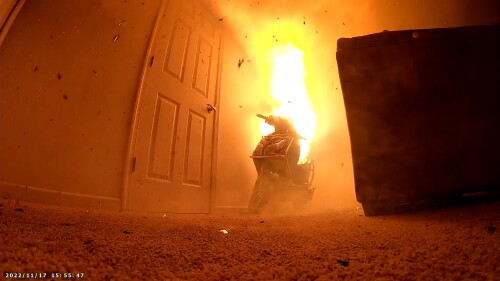The U.S. Fire Administration (USFA) plays a critical role in enhancing public safety by supporting fire prevention, preparedness and response efforts nationwide. To capture the team’s work in these areas, the USFA released a report summarizing its 2024 accomplishments, providing a comprehensive overview of the USFA’s progress in addressing critical challenges and advancing key priorities within the fire service.
Highlights include:
- Advancing fire safety technology: The USFA has made significant strides in integrating innovative technologies to improve fire prevention and suppression methods.
- Tackling emerging threats: The agency has focused on addressing complex fire risks, including the increasing prevalence of wildfires and the unique hazards posed by lithium-ion battery fires.
- Expanding outreach to underserved communities: Targeted programs aimed at improving fire safety education and resources in historically underserved areas have been expanded.
- Strengthening firefighter health and wellness: The USFA continues to prioritize the physical and mental wellbeing of firefighters, implementing new initiatives to support health and wellness.
- Fostering collaboration across industry agencies: Enhanced cooperation and resource sharing among fire service organizations have bolstered emergency response capabilities nationwide.
This report not only highlights the agency’s achievements but also outlines its ongoing commitment to addressing the evolving needs of the fire service and the communities it serves.
Following is a closer look at these initiatives as well as related FireRescue1 resources. Download the full USFA report below.
NERIS launch
The USFA and its partners at the Department of Homeland Security (DHS) Science and Technology Directorate (S&T) launched Phase 1 of the National Emergency Response Information System (NERIS) analytics platform. The first 165 fire departments have been successfully onboarded. Throughout 2025, thousands of fire departments from across the nation will continue to onboard the new platform. NERIS will replace the legacy National Fire Incident Reporting System (NFIRS) data system, which will be decommissioned in December 2025.
Li-ion battery fires
Electric vehicles (EVs) and other appliances powered by lithium-ion (li-ion) batteries are a growing concern for fire departments.
During a February 2024 congressional hearing, U.S. Fire Administrator Dr. Lori Moore-Merrell underscored the dangers of li-ion battery fires and how quickly they can become unmanageable: “In fires where these devices are involved, there is often only 15 seconds from the first sign of smoke to thermal runaway and explosion, with windows blown out and fire burning in homes, apartments and businesses.”
To combat these concerns, the USFA worked with the FDNY and UL’s Fire Safety Research Institute (FSRI) to launch the Take Charge of Battery Safety initiative. The agency also worked with DHS S&T to host a lithium-ion battery symposium at FDNY, bringing together researchers, policymakers and fire service leaders to discuss fire risks associated with lithium-ion batteries.
Structure fire
As structure fires continue to cause firefighter and civilian injuries and deaths, the USFA supported FEMA’s Building Codes Work Group and Mitigation Framework Leadership Group’s Building Codes Task Force to better incorporate fire as a hazard and a potential disaster across the federal ecosystem.
The USFA completed FEMA/USFA “Building Codes Save: Fire Hazards Pilot Study” and co-authored “Truck Mounted Attenuators” information sheet with the National Institute for Occupational Safety and Health (NIOSH).
Wildfire and community conflagration
Massive wildfires impacted the United States in 2024, including the devastating Lahaina, Hawaii, blaze. The USFA completed four post-wildfire visits to the area, engaging the local government, the fire department and the community. This engagement resulted in the USFA collaborating with DHS S&T to deploy artificial intelligence-enabled fire sensors to mitigate fire risks in Hawaii.
The USFA took additional strides to mitigate the impact of WUI fires:
- Worked with the DHS Supply Chain Resilience Center, in partnership with the FEMA Defense Production Act Team and FEMA Region 9 to identify the Firehawk contracts in need of priority ratings and begin the process of issuing priority rated contracts under the Defense Production Act. These efforts will give CAL FIRE and other local fire departments priority access to the critical parts needed and ultimately help ensure the availability of the much-needed aerial assets to support wildfire response.
- Collaborated with Greece’s Ministry of Citizen Protection/Center for Security Studies (KEMEA), National Institute of Standards and Technology, and U.S. Agency for International Development to deliver a 2-day summit/workshop (March 2024) in Athens on a wildfire in the wildland-urban interface (WUI).
- Built and maintained a steady working relationship with the Gordon and Betty Moore Foundation based on joint areas of interest. The relationship was formalized with a memorandum of understanding signed at the White House. The memorandum includes a work plan to address the threat of wildfires in the wildland urban interface.
- Summarized the current national wildfire activity through the Senior Leadership Dashboard. It used the most authoritative, publicly available data services to provide insights on wildfire activity over the past 7 days and historical wildfire trends over the past 10 years.
- Created the WUI Property Awareness Explorer and WUI Community Awareness Explorer dashboards to raise awareness of WUI areas throughout the U.S. and help residents know where they live in proximity to WUI and fire-prone areas.
- Partnered with DHS S&T to deliver wildfire sensors to fire prone areas of East Tennessee including Sevier County, Gatlinburg and Pigeon Forge, providing innovative technology to assist in making the area more fire adapted.
Partnerships and international engagement
While increasing collaboration and unity between U.S.-based fire service organizations, the USFA also engaged with international fire partners and industry experts to expand the agency’s working knowledge of global fire tactics and increase cooperation on fire-related concerns that span continents:
- Collaborated with #FireServiceOneVoice group to host the 2024 Winter Ready Fire Stop Tours to create greater awareness within FEMA, the federal government, and local, state and tribal governments about fire deaths and fire safety measures during winter months.
- Engaged the World Bank (WB), which resulted in the WB sponsoring developing countries’ participation in the World Fire Congress.
- Secured WB support for the 2026 World Fire Congress in the United Kingdom (UK) to achieve greater diversity and equal access to this global community.
- Led the FEMA/UK work groups on firefighter health and safety issues, delivering the first report on firefighter mental health during the 2024 U.S. Fire Administrator’s Summit.
- Engaged with top fire officials in Japan and Singapore to learn from fire resource deployment models and training capabilities and to secure the technologically advanced countries’ support to the World Fire Congress and subsequent community of practitioners.
- Created a working relationship with the United Nations (UN) Office of Disaster Risk Reduction, and the European Union’s European Civil Protection and Humanitarian Aid Operations to elevate USFA within the global disaster management community. The U.S. Fire Administrator spoke at the UN on the impact of wildfire on communities.
EMS response
The USFA amended the contract for the “Operational Templates and Guidance for EMS Mass Incident Deployment” to add a section on mass care during widespread wildfire smoke incidents. It also served as the 2024 chair of the Federal Interagency Committee on Emergency Medical Services.
Recruitment and retention
The National Fire Academy (NFA) cofacilitated the USFA’s Work Group on Recruitment and Retention to identify nearly 100 best-practice organizations in over a dozen categories. This work was shared at the 2024 U.S. Fire Administrator’s Summit through presentations at conferences around the nation, podcasts and social media posts.
Additionally, the NFA developed a new 2-day class called “Fostering Belonging in the Fire and Emergency Services” (F/W0851), a valuable tool for career and volunteer fire and EMS recruitment efforts. The NFA also released a new “Retention and Recruitment for the Volunteer Emergency Services” manual.
Lastly, the USFA partnered with the Centers for Disease Control and Prevention on “Safety and Health Considerations for Junior Firefighters.”
Health and safety
The USFA was actively involved in efforts with the Department of Defense, DHS, Federal Aviation Administration, Occupational Safety and Health Administration and external fire service stakeholders on PFAS-free firefighting gear and foam.
Legislation
It was a busy year for Congress, with several bills related to the fire service and public safety signed into law.
On July 9, President Biden signed the Fire Grants and Safety Act, PL 118-67 (S. 870 and H.R. 4090), reauthorizing the USFA along with the Assistance to Firefighters Grant Program and the Staffing for Adequate Fire and Emergency Response Grant Program.
On Sept. 26, Biden signed the Supporting and Improving Rural EMS Needs (SIREN) Reauthorization Act, PL 118-84 (S. 265 and H.R. 4646), reauthorizing the SIREN grant program for improving EMS in rural areas.
On Dec. 4, the Senate passed the Firefighter Cancer Registry Reauthorization Act (H.R.3821) which had previously passed the House by a huge bipartisan vote and will now be sent to the President’s desk to be signed into law. The Firefighter Cancer Registry Reauthorization Act will reauthorize the NIOSH National Firefighter Registry (NFR) for Cancer. The purpose of the NFR is to help understand and reduce cancer risk among firefighters. The bill extends the NFR’s reauthorization through fiscal year 2028 and raises the authorization level from $2.5 million to $5.5 million per year.
Looking ahead
In 2024, several pieces of fire- and EMS-related legislation were passed by Congress. What does 2025 hold for first responders? Learn what a second Donald Trump administration could mean for both firefighters and EMS providers.
Download the full USFA 2024 accomplishments report:


















